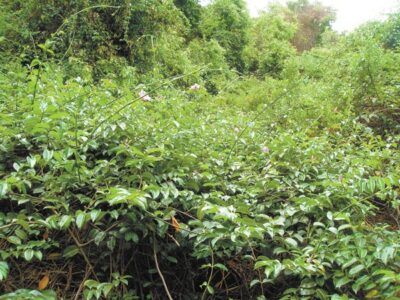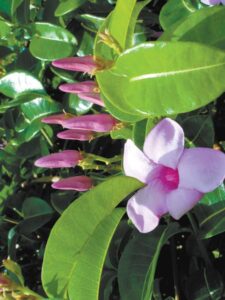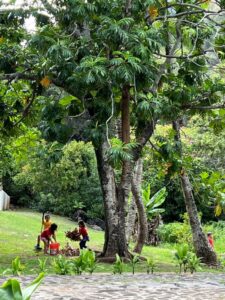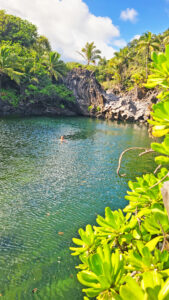Shiny leaves and purple flowers? Check that it’s not a poisonous rubber vine
Kia‘i Moku
In 2003, Lori Buchanan, manager of the Molokai/Maui Invasive Species Committee, investigated a glossy-leaved plant with pinkish-purple flowers. She had seen it growing as a shrub in a handful of yards, but along the coast in Kamalo and Ualapue, this same plant had climbed up kiawe trees and created such a tangle of vines in the canopy that it blocked the light underneath.
Forest and Kim Starr, early detection specialists with the Maui Invasive Species Committee, confirmed her suspicions: the plant was rubber vine (Cryptostegia sp.). The Hawaii Pacific Weed Risk Assessment categorizes it as high risk, or very likely to be invasive. Since the plant was only growing in a few places, Buchanan and her team decided to remove it. At the time, the MoMISC crew only had two staff, including Buchanan, so field staff from MISC came over to help. They spent the week chopping and hacking the vines from the forest.
“It was dirty, hard work,” says Buchanan. Rubber vine is toxic and inhaling dust from dried plant material can trigger violent coughing and cause noses to swell and eyelids to blister. Coming into contact with the plant’s milky sap can produce burning rashes and blisters. “Everyone was covered head to toe, wearing safety glasses and breathing though bandanas,” she recalls.
By the end of the week, the crew had knocked back the worst of the infestation. MoMISC would return to remove smaller plants as they sprouted. Then Buchanan approached the residents who had the plants in their yards growing as shrubs.
Shiny leaves and purple flowers led to the plants’ popularity as an ornamental, and the plant spread from its native Madagascar to Hawaii, Australia, the Caribbean, East Africa and India. The latex sap that leaks from a cut stem inspired the name — this sap can be processed into rubber. But its viny nature creates a different cause for concern.
With enough water, rubber vine can grow 15 feet in a single month. Woody tissue helps support the plant. On its own, it can become a 7-foot-tall shrub, but if there’s a tree nearby, the vine will climb the trunk, reaching lengths of nearly 100 feet, stretching along the top of the forest canopy. These vines shade the trees they support and weaken them. And if a storm comes, the tangle of vines can take down multiple trees.
In Hawaii, the impacts of a climbing vine can be even worse. Native rainforests have an open-canopy structure and a fast-growing vine can smother native trees and shade out understory plants.
This plant poses a threat to more than just the environment. In addition to causing blisters and respiratory problems, the sap also contains cardiac glycosides that can interfere with heart functions in humans and other animals. In Australia, rubber vine in pasturelands has caused the death of livestock that munch on the plant. The toxins are so potent that ingesting the leaves reportedly killed an otherwise healthy elephant in India.
On Molokai, the continued efforts of the MoMISC crew have paid off. In 2004, rubber vine infestations had been detected at a half-dozen “wild” sites, 15 yards and one business. Today, only two sites remain and the MoMISC crew returns to remove any the seedlings.
“Looking back, even though it has taken so long, I’m so glad we took on rubber vine,” said Buchanan. “Knowing rubber vine is no longer a threat to Molokai makes all the difference.”
But the struggle isn’t over elsewhere in Maui County. Every so often crews come across another rubber vine plant, either recently planted or overlooked by homeowners for years. A new location was reported on Maui just this April. Throughout the state, the island-based Invasive Species Committees are searching for and removing this plant.
Your help in finding this invasive species can protect Hawaii from the damage it causes. Learn more about the plant, including identification tips, at maui
invasive.org/rubber-vine. Report sightings through the 643PEST reporting system by calling 643-PEST (7378), or submit a report online at 643PEST.org. You can find ornamental plants that don’t pose a risk of invasion in Hawaii at plantpono.org.
* Lissa Strohecker is the outreach and education specialist for the Maui Invasive Species Committee. She holds a biological sciences degree from Montana State University. “Kia’i Moku, Guarding the Island,” is prepared by the Maui Invasive Species Committee to provide information on protecting the island from invasive plants and animals that can threaten the island’s environment, economy and quality of life.
- On Molokai, rubber vine escaped cultivation to take over acres of forest in Kamalo. Twenty years later, crews still return to pull up any tiny seedlings and keep this plant under control. Photos courtesy MISC
- Report sightings of rubber vine in Hawai‘i to 643PEST.org. The white midrib on the leaf helps distinguish this poisonous plant from other lookalikes. Photos courtesy MISC







